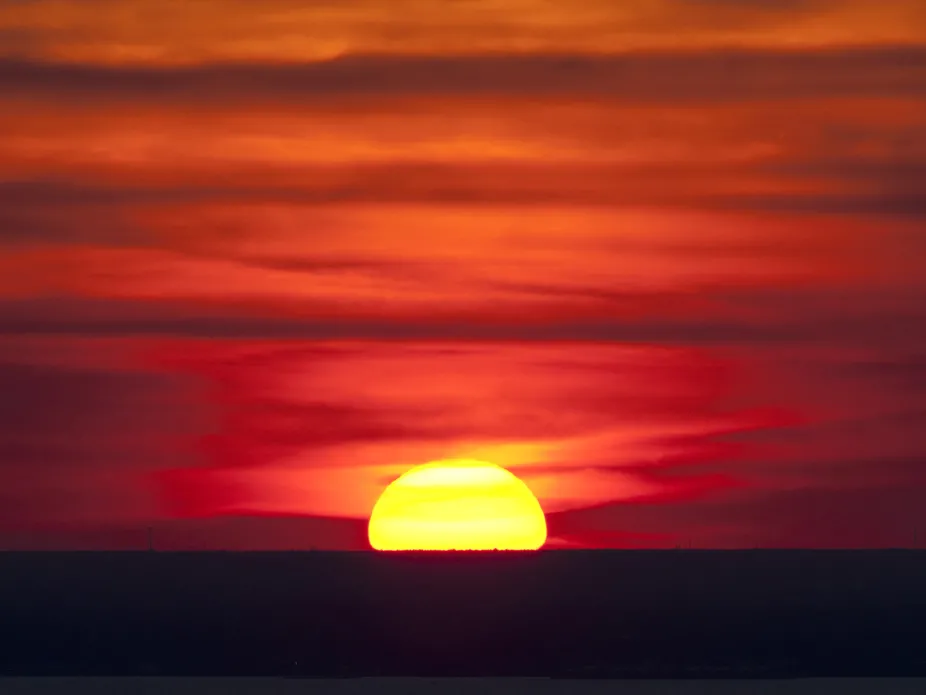The Appearance of the Sky
The colors we see in the sky come from sunlight that is scattered by molecules in the atmosphere. This process is called Rayleigh scattering. Nitrogen and oxygen make up most of the molecules in our atmosphere, but any gas or aerosol suspended in the air will scatter rays of sunlight into separate wavelengths of light. Consequently, when there are more aerosols in the atmosphere, more sunlight is scattered, resulting in more colorful skies.
Why Is the Sky Blue?
Sunlight is made up of all the colors of light. It appears as white light when all the colors are together. Sunlight travels as waves of energy, and different colors of light have different wavelengths. Red light has long wavelengths, while blue light has short wavelengths. Light bounces off of air molecules in the Earth's atmosphere, scattering in all directions. Blue light is scattered more than other colors of light because of its shorter, smaller waves. Because blue light is scattered more than other colors of light, the sky appears blue.

The visible light region of the electromagnetic spectrum is made up of different sized wavelengths of light. Each wavelength defines a unique color. All wavelengths of visible light together make up white light.
NASA

A rainbow over Nederland, Colorado.
UCAR
How Does a Rainbow Form?
Rainbows result from light that scatters inside of water droplets. This is why you only see rainbows after it has rained, when there is water in the atmosphere and the Sun is shining. Sunlight enters a rain droplet and refracts, or bends, as it travels through the droplet. Shorter wavelengths of light bend more than longer wavelengths of light, causing the sunlight to separate into the full spectrum of visible light as it exits the droplet. The resulting rainbow is visible with the longest wavelengths (red) at the top, and the shortest wavelengths (violet) at the bottom.
Why Are Sunrise and Sunset so Colorful?
The angle of sunlight as it enters the atmosphere also affects the color of the sky. During sunrise or sunset, when the Sun is close to the horizon, the light must travel through more of the atmosphere than it does when the Sun is overhead. This results in more scattering of light, including longer wavelengths such as yellow, orange, and red, which creates colorful sunrise and sunset skies.

Vivid sunset over NASA’s Kennedy Space Center in Florida (U.S.). The stunning colors result from particles in the atmosphere scattering light from the Sun. When there are more particles in the air, more light is scattered, and the colors are enhanced.
UCAR
How Does Air Pollution Affect Sunset Colors?
Intense red sunsets are often visible when forest fires are burning nearby, or when volcanic eruptions happen. The most heavily polluted cities in the world also tend to have more orange and red sunsets, resulting from an abundance of human-made aerosols. Though the result can be spectacular to observe, it is also an indication of increased air pollution.
Why Does the Sky Look Different Throughout the Year?
Certain times of the year tend to have more aerosols in the air than others, which leads to more colorful skies. In certain climates, the air tends to be dustier during the summer months, due to hot, dry weather. In the fall, when many farmers harvest their crops, more dust is suspended in the air. The full moon in the fall, called the Harvest Moon, often appears orange because of the extra dust particles in the sky. As with red sunsets, the unusual Moon coloration might be pleasing to the eye, but it is a sign of poor air quality.
Sundogs

Peggy LeMone
Sundogs are brightest in winter because ice crystals are more common, but can be seen at other times of year as well. A sundog (also called a mock sun or parhelia) is a brightly colored spot that appears along one, or both, sides of the Sun. Sundogs most often form when there are cirrostratus clouds covering the sky and the Sun is near the horizon. The cirrostratus clouds are made of hexagonal ice crystals which bend light, creating sundogs and other atmospheric optics such as the 22-degree halo.

A Sundog is an optical phenomenon that appears as a bright spot on each side of the Sun.
J. Ristvey